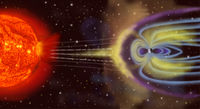
Photo from wikipedia
Abstract In addition to multi-scale spatio-temporal trends that shape the ionosphere variability, the ionosphere responds to the disturbances that are solar, geomagnetic and seismic in origin. In this study, post-seismic… Click to show full abstract
Abstract In addition to multi-scale spatio-temporal trends that shape the ionosphere variability, the ionosphere responds to the disturbances that are solar, geomagnetic and seismic in origin. In this study, post-seismic ionospheric disturbances are investigated retrospectively from 1999 to 2015 using two different sets of ionospheric maps of the F2 layer critical frequency, foF2. One set of foF2 maps is obtained by assimilating Global Ionospheric Maps (GIM) of Total Electron Content (TEC) into IRI-Plas model (IRI-Plas-foF2). Another set of hourly foF2 maps is obtained using PRIME-251 mapping technique (PRIME-foF2) by the assimilation of ionosonde foF2 data into IRI-CCIR model. The geomagnetic storms affecting the ionosphere are determined with relevant thresholds of geomagnetic AE, aa, ap, ap(τ) and Dst indices. It is observed that more than 60% of the earthquakes occur in the Equatorial Ionization Anomaly (EIA) region within the belt of geomagnetic latitudes ±40° N and geographic longitudes 90–190° E. The co-seismic foF2 disturbances, DfoF2, are identified for the cells of the map if an instant foF2 value is outside of pre-defined bounds of foF2 median (μ) and standard deviation (σ), μ ± 1σ, in the map fragment of 1000 km radius around the earthquake hypocenter. The results of positive ionospheric disturbances, DfoF2p, and negative disturbances, DfoF2n, in the EIA region during the 12 h after earthquake differ with respect to geomagnetic quiet and storm conditions, nighttime and daytime, magnitude and depth of the earthquake. The maximum spatial variability (for more than 50% of map cells in the vicinity of hypocenter) is observed with positive disturbances (DfoF2p) for the earthquakes that occurred during daytime at a depth of 70–300 km.
Journal Title: Advances in Space Research
Year Published: 2017
Link to full text (if available)
Share on Social Media: Sign Up to like & get
recommendations!